Donna May Lina and Agay Llanera
Weeks ago, Australian think-tank group Lowy Institute measured the performance of pandemic responses across the globe. With evaluations based on numbers of reported cases and deaths, tests conducted, and the rates of positive tests, the Philippines ranked 79th on the list.
But the rollout of COVID-19 vaccines may change the landscape of global pandemic recovery. According to Bloomberg, over 152 million doses of COVID-19 vaccines have so far been administered in 73 countries. This is roughly equivalent to 5.64 million doses a day.
With the first batch of COVID-19 vaccines arriving in a few days in the Philippines, health experts agree that the vaccination drive should still be supplemented by basic health and safety measures.
A year after since the Philippines reported its first COVID-19 case, how well do you know the basic precautions that could spell the difference between life and death?

To test your knowledge, go ahead and tick the Yes or No boxes of our COVID-19 Safety Checklist. If your answer is a No, check out the explainer under the Find out How column, which also provides helpful links.
| DO YOU KNOW… | YES | NO |
| 1. Where to get factual information on COVID-19?
| ||
| 2. Know the symptoms of COVID-19?
| ||
| 3. How to wash hands properly?
| ||
| 4. How to wear a face mask?
| ||
| 5. Why staying home is important?
| ||
| 6. What physical distancing is?
| ||
| 7. How to greet people without physical contact?
| ||
| 8. What essentials to put in your bag?
| ||
| 9. How to maximize digital tools?
| ||
| 10. How to work from home?
| ||
| 11. What to do when you had contact with someone with COVID-19?
| ||
| 12. Practice a healthy lifestyle?
| ||
| 13. Why it’s important to be updated daily on community news?
| ||
| 14. How to properly dispose of personal protective equipment?
| ||
| 15. How to ensure your surroundings are clean? |
| FIND OUT… |
| 1. Where to get factual information on COVID-19? It’s alarming to note that until now, there are those who believe that the COVID-19 pandemic is a hoax! Know that the health crisis is real, and that if want to read up more on it, visit these reputable websites: World Health Organization (WHO) Centers for Disease Control and Prevention (CDC) Department of Health (DOH) Get your facts straight on COVID-19 by verifying sources before sharing information on social media.
|
| 2. The symptoms of COVID-19? COVID-19 symptoms range from the most common and less common to the downright serious. Learn to differentiate these from allergy and flu symptoms. People with mild symptoms can manage them at home, but serious symptoms need medical care. Take note that it may take up to 14 days for an infected person to show symptoms.
|
| 3. How to wash hands properly? Washing hands is a basic practice we learned during childhood. Know the proper way of doing it to ensure you’re safe during and beyond the pandemic.
|
| 4. How to wear a face mask? Face masks should cover your nose, mouth and chin. WHO emphasizes the importance of handwashing or hand sanitizing before and after putting on the mask and adjusting it on your face. Here’s the updated “wearing a mask” routine.
|
| 5. Why staying home is important? Because COVID-19 spreads through droplets sneezed or coughed into the air, staying home limits the possibility of you interacting with an infected person. You may also be asymptomatic, so staying home can stop the spread of the virus.
|
| 6. What physical distancing is? When outside the home, keeping a distance of 6 feet between yourself and other people can protect you from infectious droplets. Stay away from crowded places. Practice physical distancing along with other safety measures (masks, avoid touching your face, handwashing, etc.) to reinforce personal protection.
|
| 7. How to greet people without physical contact? Say hello, wave, nod, give an air high-five, a salute, or a flying kiss. There are many ways to greet friends and family while maintaining physical distancing. Perhaps Filipinos followed these safety tips during the holidays, which was why experts noted that a spike in COVID-19 cases was not observed after the Christmas season.
|
| 8. What essentials to put in your bag? Aside from your wallet and cellphone, your bag must contain the following: · Extra face mask · Extra face shield, which you can make from plastic bottles · Alcohol · Sanitizer · Soap · Reusable bottle of water · Towel · Tissue · Your own pen to fill out contact tracing forms (since pens used by other people may contain viruses and bacteria)
|
| 9. How to maximize digital tools? From paying bills to bank transactions and buying essentials, take advantage of online services to keep you safe at home. Last September, the government launched the StaySafe.ph app, the country’s official contact tracing program. Downloading the app also allows you to monitor your health conditions and social distancing practices.
|
| 10. How to work from home? While kids learn from home, you can also learn to work from home if your company allows it. If you’re looking for work, explore remote employment opportunities found in reputable job portals, allowing you to earn from home. In this day and age, learning how to navigate video conferences in different formats is a marketable skill.
|
| 11. What to do when you had contact with someone with COVID-19? Read up on the DOH’s updated guidelines on contact tracing of confirmed COVID-19 cases. Even if you don’t feel symptoms, practice self-quarantine right away. Watch this for more home quarantine tips.
|
| 12. Practice a healthy lifestyle? There are many ways to boost immunity. The basics are incorporating fruits and vegetables in your diet; getting 7 to 8 hours of sleep daily; regular exercise; and maintaining a positive outlook to facilitate your mental health.
|
| 13. Why it’s important to be updated daily on community news? Visit your LGU’s website and follow its social media accounts to know the latest programs you can avail of. Keep track of the active cases in your barangay. Update yourself on your area’s vaccination plans.
|
| 14. How to properly dispose of personal protective equipment? According to WHO, disposable masks should be replaced as soon as they are damp. After removing the used mask without touching its front, immediately throw it in a closed bin and wash hands. To avoid passing on the virus, the UK government recommends putting the used face mask in a plastic bag, and discarding it in another bag dedicated to infectious waste. But environmental advocates warn about how the rampant use of disposables can worsen the climate emergency, which may also have fueled the pandemic. To mitigate waste, some recommend reusable masks, which you can also make.
|
| 15. How to ensure your surroundings are clean? Frequently touched surfaces such as door knobs, light switches, phones and toilets should be cleaned and disinfected regularly. After cleaning these fixtures with detergent and water, disinfect them with this DIY formula. |
With this checklist, we hope you learned something new, or at least remembered what we all need to keep doing. Get these basics down pat, and always comply with safety measures. Even with the arrival of COVID-19 vaccines, we can’t let our guard down. The true key to pandemic recovery lies in awareness, consistency and vigilance.
Donna May Lina with Agay Llanera
It’s been a little over a year since the Philippines reported its first COVID-19 case. Since then, our lives have drastically changed. To reduce the spread of the virus, we all had to learn the basic protocols: wash our hands, wear a mask, maintain physical distance. Guidelines were set out on international, national and barangay levels.
Just a few weeks ago, Lowy Institute, an Australian think-tank group, compared the effectiveness of the different countries’ pandemic responses. Criteria included the numbers of reported cases and deaths, tests conducted, and the rates of positive tests. On the list, the Philippines ranked 79th in terms of COVID-19 performance. Top countries that were able to control the virus were New Zealand (1st), Vietnam (2nd), Taiwan (3rd) and Singapore (13th).
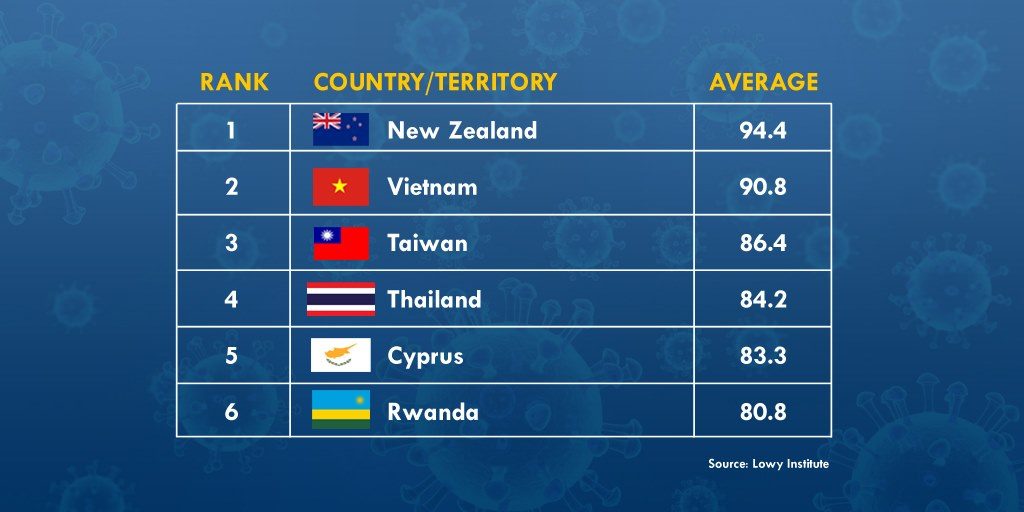
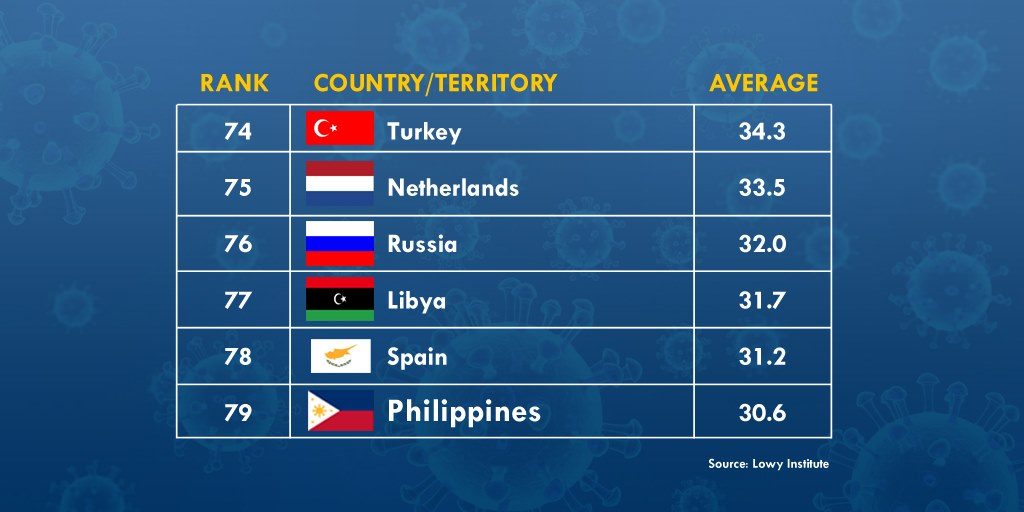 (Source: Lowy Institute)
(Source: Lowy Institute)
What did they do right?
For one, these countries have very clear guidelines. The New Zealand government has created separate COVID-19 safety websites for specific audiences—the business and service sector, workers, and even for its construction industry. Taiwan has only seven pandemic-related deaths because of its tight entry restrictions. As early as February last year, travelers with Taiwanese mobile numbers have been utilizing the QR code system for health declarations. Even home quarantine and isolation monitoring are done via mobile phones; if a person left quarantine, his or her phone will alert authorities who will immediately verify the person’s location.
With clear guidelines come clear penalties. To compare how the Philippines compares with other countries in meting out fines for the simple safety protocol of wearing face masks, Panahon TV came up with this chart:
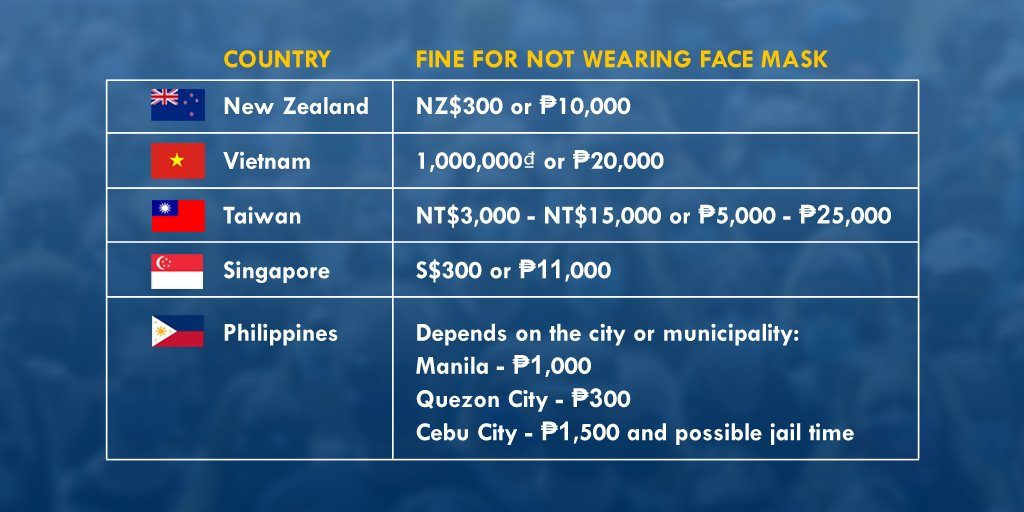
With local government units in our country having their own penalties, guidelines become confusing especially for travelers. A quick web search on sanctions for those failing to comply with COVID-19 safety protocols also revealed the following:
- New Zealand nips irresponsible behavior in the bud by imposing a fine of NZ$4,000 (₱14,000) for travelers who refuse to test for COVID-19. Violators can be held for 28 days.
- In Vietnam, those who escape quarantine sites, avoid quarantine measures, and fail to complete health declarations face criminal punishment.
- When an OFW left his room at a quarantine hotel in Taiwan for eight seconds, he was fined NT$100,000 (₱172,000).
- Those who fail to comply with Stay-Home Notice requirements in Singapore may be penalized up to S$10,000 (₱360,000) and/or imprisonment of up to six months.
- The farthest the Philippine government has gotten in this area is the mere suggestion of imposing community service and fines for quarantine violators. As of writing, no clear penalties have been drafted.
Factors that Contribute to Pandemic Response
Politics and location play a big role in the different pandemic responses across the globe. Vietnam and Taiwan are known for their disciplined citizens because they have always been challenged by threats of war. Due to geographical reasons, New Zealand has learned to be self-contained. A strict compliance with laws has always been the key component of Singapore’s governance.
Culturally, these countries have a more collectivist culture. Social psychologists define collectivism as a value that emphasizes interconnectedness, prioritizing a society’s goal and needs over those of the individual.
Interestingly enough, countries known for their individualistic cultures seem to have weaker pandemic responses, as listed by the Lowy Institute’s report. These include Sweden (37th), the UK ( 66th), Netherlands (75th) and the U.S. (94th).
A Centers for Disease Control and Prevention commentary observes how COVID-19 measures seem to focus more on individual risks, which lead to gaps in response. In order to curtail the global spread of the virus, messaging should promote cultural inclusivity. But instead of pitting one culture type against the other, the commentary suggests embracing “multicentric logics – individual, collective, and everything in between.” Different cultures and attitudes are factors in seeing how countries will be able to implement, comply, and continue to maintain safety guidelines to this date.
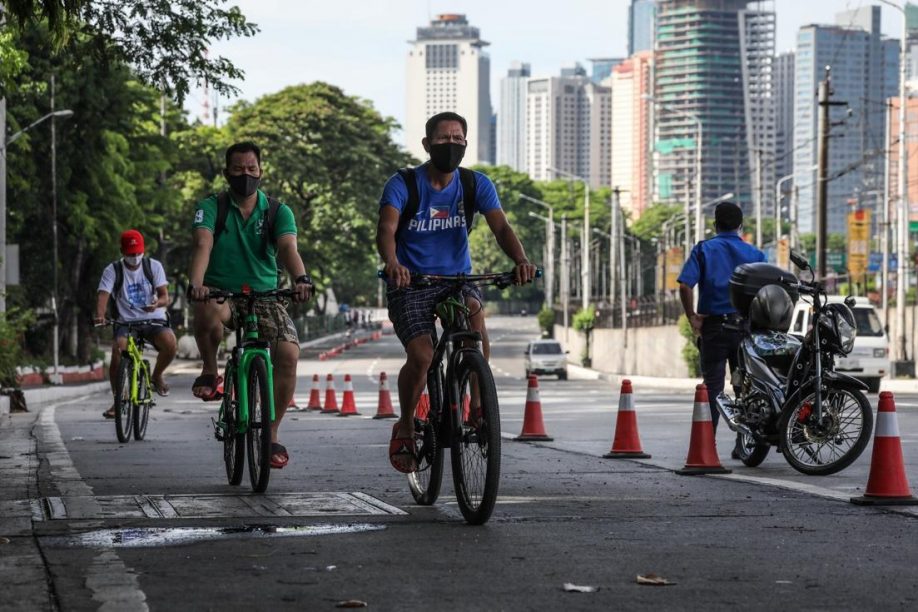 (photo by Jire Carreon)
(photo by Jire Carreon)
How will the pandemic end?
In an attempt to answer this question, the New York Times discussed how the 1918 Spanish flu virus, which killed as many as 100 million people worldwide, has simply lost steam, evolving into a still potentially fatal seasonal flu.
With the vaccine race “won” in round one by pharmaceutical companies like Moderna (U.S.) and AstraZeneca (UK), more than 108 million vaccine doses have been administered in 67 countries.
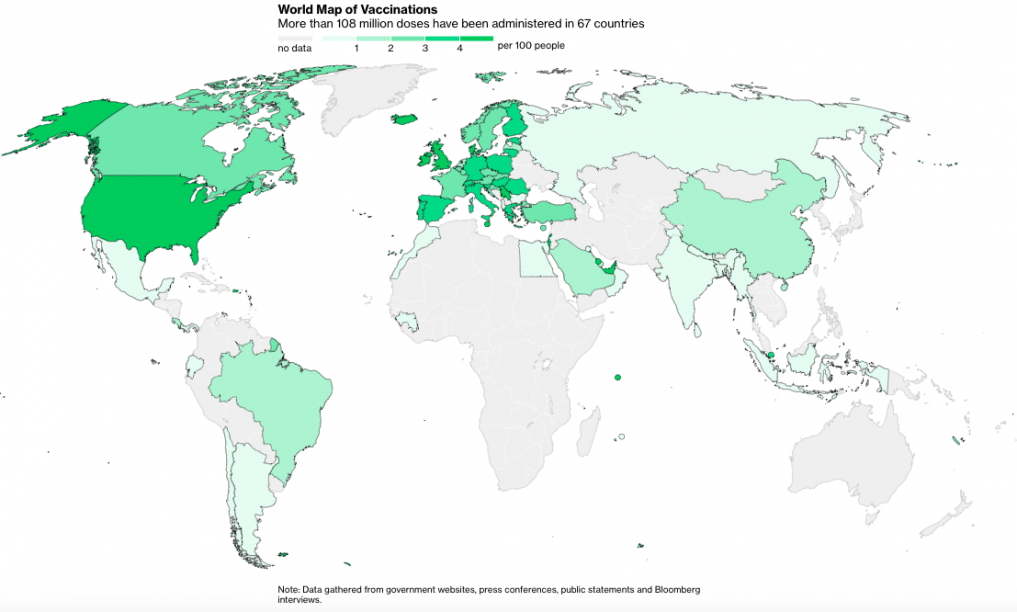 (Source: Bloomberg)
(Source: Bloomberg)
The vaccines were developed through collaborating scientists, were tested among selfless volunteers, and rolled out to countries’ frontliners and vulnerables depending on government strategy. Through modern technology and cooperation, vaccination has been conducted through Emergency Use Authorization, allowing the release of unregistered drugs and vaccines during a public health emergency. No other vaccine has been rolled out this fast.
But we will still need to work together and faster. The virus is mutating, and has evolved into variants from the UK, South Africa and Brazil, which are being closely monitored by health experts. Though vaccination seems to be the best solution in ending the pandemic, it doesn’t mean that the virus will magically disappear.
The Philippines is reported to receive the vaccines by the second quarter of this year. While we all wait for the vaccine rollout in our country, the best thing for us to do is to comply to safety standards.
The Philippine government has basic taglines for the people’s easy recall. Repetition has always been an effective communication tactic. There’s the Department of Public Work and Highway’s Build, Build, Build; and the Department of Agriculture’s Plant, Plant, Plant.
We should all then Comply, Comply, Comply to washing our hands. Comply, Comply, Comply to wearing face masks. Comply, Comply, Comply to maintaining physical distance. Comply, Comply, Comply to answering contact trace forms.
This may be easier said three times than done, but if we want our country to fare better, we must continue fighting the good fight despite quarantine and protocol fatigue. In this global crisis, there is no room for complacency, only repetitive compliance. Whether you’re privileged, careless, or downright indifferent, one thing is clear: the virus does not care.
